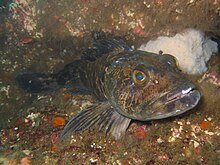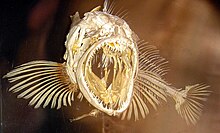Ling Cod
| Ling Cod | ||||||||||||
|---|---|---|---|---|---|---|---|---|---|---|---|---|

Ling Cod ( Ophiodon elongatus ) |
||||||||||||
| Systematics | ||||||||||||
|
||||||||||||
| Scientific name of the subfamily | ||||||||||||
| Ophiodontinae | ||||||||||||
| Jordan & Gilbert , 1883 | ||||||||||||
| Scientific name of the genus | ||||||||||||
| Ophiodon | ||||||||||||
| Girard, 1854 | ||||||||||||
| Scientific name of the species | ||||||||||||
| Ophiodon elongatus | ||||||||||||
| Girard , 1854 |
The Ling Cod or Lingcod ( Ophiodon elongatus ) is a north- east Pacific perch- like tiger from the Hexagrammidae family and the only species in its genus . It is not related to the ling or other cod (Gadidae), but has certain ecophysiological similarities to them.

description
The cod becomes over 1.5 m long, weighs almost 60 kg and is over 20 years old. The head is bare, otherwise the body is covered with small ctenoid scales. The very different coloration can best be described as light gray, marbled green to dark brown (often with many dark spots). The fins sometimes have bright, colorful spots. The large, round pectoral fins are often brightly edged. A small skin process (cirrus) stands over each eye. The mouth is large, the dentition consists of a lot of large dog teeth and in between smaller, also pointed teeth (hence the name Ophiodon , "snake- tooth "). Sharp teeth are also found on vomer and palatina (on the "palate") as well as on the pharyngealia and the branchial arch (as branchiospins ).
Fin formula : D XIV – XVII / 21–24, A III / 21–24, P 19, VI / 5, C ~ 26 (including the pre-rays, see fig. Skeleton).
The dorsal fin appears divided by constrictions and thus reminds a little of the two or three dorsales of the codfish. The A-spines are completely sunk into the skin of large specimens. The V stand a little behind the P base. The tail fin is almost “cut off” at the rear. The spine consists of 55-59 elements. Although it belongs to the family of the Hexagrammidae ("Sechsliner"), it only has one sideline .
Way of life
This fish lives close to the coast and near the bottom (it has no swim bladder ) from the surf zone to a depth of almost 500 m, especially on rocky ground with zoophytes - or algae ( seaweed ) growth, where it also appears well camouflaged. There are both stationary and wandering individuals (or populations? - he's not completely unsociable). The young live in the shallower, sandy bays, sea grass meadows and the like. The like, mainly of planktonic and benthic copepods and other small crustaceans; "Adults" (better: sexually mature) eat not only benthic crabs (crabs and the like) but also octopus and ten-foot cuttlefish as well as fish such as herrings, cod, flatfish and others, most of which they prey as lurking shock predators.
Sexual maturity occurs around the age of 4 (females around 70 and males around 40 cm in length), after which the females grow much stronger and also get older than males (which can be recognized by a small genital papilla). From November to March, the females in particular can undertake smaller spawning migrations towards the coast, while the dark-colored males are already "marking out" territories there; the spawn is then deposited benthically (in crevices, hollows with a flow) (sometimes by several females) and guarded by the father until the larvae (after four to eight weeks, in April, May) disappear into shallow waters. A large female can shed hundreds of thousands of (small, sticky) eggs (up to 7 kg of spawn, in several layers) - in the sea, despite brood care, such high numbers are necessary (the male can keep aggressive predators away from the spawn - it sometimes even bites off photographing divers -, but not secret ones like snails, starfish, sea urchins, which it doesn't "notice").
Spread and endangerment
The cod occurs from Alaska (also Bering Sea ?) To Baja California - so it needs cooler (5–16 ° C) waters. It also resembles the North Atlantic cod with its vitamin A (+ D) -rich cod liver oil - the liver serves as a buoyancy aid - and is a popular angler fish, but also commercially exploited ( bottom net ) fish that is marketed and also in various ways is prepared (the meat is greenish raw, but turns white when cooked or roasted). In addition, it is an important food for the seals.- A vernacular name of the fish, "kultus" (among Indians of the northwest coast of the USA), meant "low value" - it was simply less valued at that time than the buttes. Today it is already overfished (e.g. on the coast of Washington), so that protected areas have been established for the juvenile fish. Artificial incubation has been researched, but not yet profitable. Due to the careless discharge of wastewater from mining companies, the consumption of Lingcod can be a health hazard in certain regions (due to its mercury content; e.g. in Alaska).
literature
- WN Eschmeyer, ES Herald, and H. Hammann (1983): A field guide to Pacific coast fishes of North America. Houghton Mifflin Company, Boston, USA
- WL Smith and WC Wheeler (2004): Polyphyly of the mail-cheeked fishes (Teleostei: Scorpaeniformes): Evidence from mitochondrial and nuclear sequence data.- Molecular Phylogenetics and Evolution 32: 627-646.
Web links
- Ling Cod on Fishbase.org (English)
- Skull s. http://www.archive.org/stream/fishskullsstudyo00gregrich (p. 332)
- Spawning behavior s. http://spo.nmfs.noaa.gov/mfr551/mfr5513.pdf
- Biology s. http://www.montereybayaquarium.org/animals/AnimalDetails.aspx?enc=QSs/4L4WTokFjgRufIzN5Q
- Health concerns s. http://www.edf.org/page.cfm?tagID=15732
- Analysis and recommendations for rebuilding the population s. http://www.pcouncil.org/bb/2004/0304/exe2at1ling.pdf


